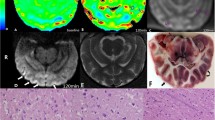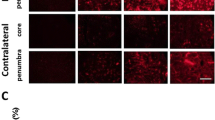Abstract
In a model of focal cerebral ischaemia, enlargement of ischaemic tissue by ischaemic brain oedema is one of the major problems in the measurement of infarction volume. To minimize an error of this overestimation, several methods have been proposed. However, there has been no attempt to compare these methods to elucidate their eligibility in the measurement of ischaemic area.
The authors used three different morphometric analyses in the measurement of infarction volume to assess the antiischaemic affects of a competitive NMDA antagonist, D-CPPene in MCA occlusion model of the rat: a direct measurement, the Swanson’s method, and a measurement using a diagram.
Post-occlusion treatment of D-CPPene (4.5 mg/kg, i.v.+3 mg/kg/ h, i.v.) produced reduction of infarction volume to about 40% compared to the control (P < 0.05). The volume of infarction determined by the direct measurement was much larger than that by Swanson’s or diagram method (P < 0.05), about 70% larger in the control and by two times in the treated. However, there was no significant difference in the measured volume between the Swanson’s and diagram methods. The protection rate, which was calculated as % = (infarct volume of the control — that of the treated/infarct volume of the control) x 100%, was larger in the Swanson’s and diagram methods than in the direct measurement.
In conclusion, it is confirmed that the direct measurement at the peak time of ischaemic brain oedema brings about not only an overestimation of infarction volume but lower protection rate also, compared to the methods designed to minimize the overestimation. Our results also demonstrate the diagram method is useful in reducing overestimation of infarct volume that may be caused by ischaemic brain oedema, though this method was not designed for the purpose of avoiding oedema at first.
Access this chapter
Tax calculation will be finalised at checkout
Purchases are for personal use only
Similar content being viewed by others
References
Avendano C, Roda JM, Carceller F, Dies-Tejedor E (1995) Morphometric study of focal cerebral ischemia in rats: a stereo-logical evaluation. Brain Res 673: 83–92
Brint S, Jacewick M, Kiessling M, Tanabe J, Pulsinelli WA (1988) Focal brain ischemia in the rat: Method for reproducible neocortical infarction using tandem occlusion of the distal middle cerebral and ipsilateral common carotid arteries. J Cerebr Blood Flow Metab 8: 474–485
Hiramatsu K, Kassell NF, Goto Y, Soleau S, Lee KS (1993) A reproducible model of reversible, focal, neocortical ischemia in Sprague-Dawley rat. Acta Neurochir (Wien) 120: 66–71
Jacewicz M, Brint S, Tanabe J, Wang XJ, Pulsinelli WA (1990) Nimodipine pretreatment improves cerebral blood flow and reduces brain edema in conscious rats subjected to focal cerebral ischemia. J Cereb Blood Flow Metab 10: 903–913
Kondo T, Reaume AG, Huang TT, Carison E, Murakami K, Chen SF, Hoffman EK, Scott RW, Epstein CJ, Chan PH (1997) Reduction of CuZn-Superoxide dismutase activity exacerbates neuronal cell injury and edema formation after transient focal cerebral ischemia. J Neurosci 17: 4180–4189
Lin TN, He YY, Wu G, Kohan M, Hsu CY (1993) Effect of brain edema on infarct volume in a focal cerebral ischemia model in rats. Stroke 24: 117–121
Osborne KA, Shigeno T, Balarsky AM, Ford I, McCulloch J, Teasdale GM (1978) Quantitative assessment of early brain damage in a rat model of focal cerebral ischaemia. J Neurol Neurosurg Psychiatry 50: 402–410
Park CK, Nehls DG, Graham DI, Teasdale GM, McCulloch J (1988) The Glutamate antagonist MK-801 reduces focal ischemic brain damage in the rat. Ann Neurol 24: 543–551
Park CK, McCulloch J, Kang JK, Choi CR (1992) Efficacy of D-CPPene, a competitive N-methyl-D-aspartate antagonist in focal cerebral ischemia in the rat. Neurosci Lett 147: 41–44
Park CK, McCulloch J, Kang JK, Choi CR (1994) Pretreatment with competitive NMDA antagonist D-CPPene attenuate focal cerebral infarction and brain swelling in awake rats. Acta Neurochir (Wien) 127: 220–226
Swanson RA, Morton MT, Taso-Wu G, Salvalos RA, Davdson C, Sharp FR (1990) A semiautomated method for measuring brain infarct volume. J Cereb Blood Flow Metab 10: 290–293
Author information
Authors and Affiliations
Editor information
Editors and Affiliations
Rights and permissions
Copyright information
© 2000 Springer-Verlag Wien
About this paper
Cite this paper
Park, CK., Kang, SG. (2000). Effects of Brain Oedema in the Measurement of Ischaemic Brain Damage in Focal Cerebral Infarction. In: Mendelow, A.D., et al. Brain Edema XI. Acta Neurochirurgica Supplements, vol 76. Springer, Vienna. https://doi.org/10.1007/978-3-7091-6346-7_55
Download citation
DOI: https://doi.org/10.1007/978-3-7091-6346-7_55
Publisher Name: Springer, Vienna
Print ISBN: 978-3-7091-7257-5
Online ISBN: 978-3-7091-6346-7
eBook Packages: Springer Book Archive




